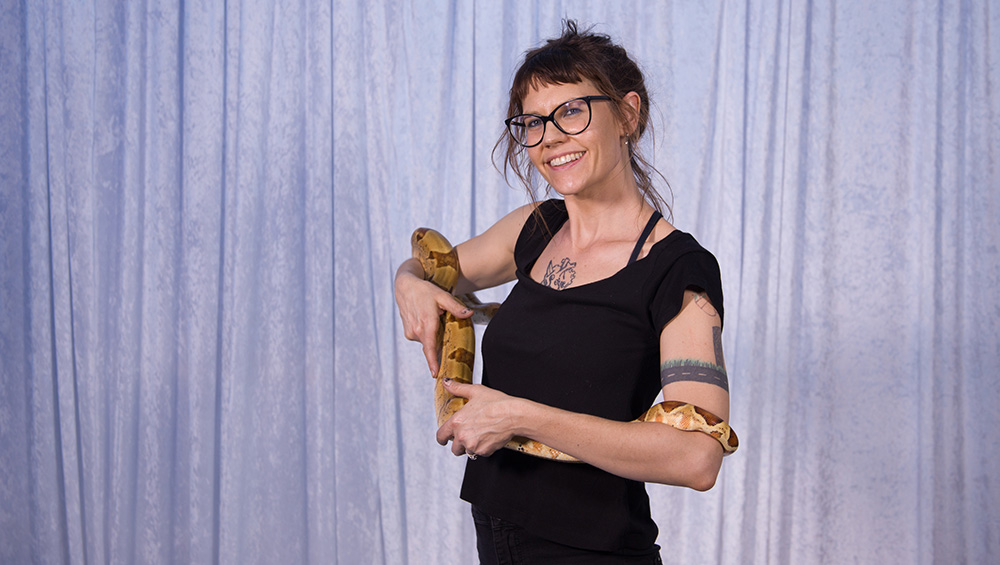
Trulee Hall. Photo courtesy of the artist.
by ANNA McNAY
Following her sold-out opera commission just before lockdown in March, the Los Angeles-based artist Trulee Hall (b1976, Atlanta) has returned to the Zabludowicz Collection in London to create her first solo institutional European show. Comprising works from the collection (acquired from her major LA show last year), elements from and a video of the opera, and a number of new pieces, the exhibition is fully immersive and promises to transport visitors to an alternate reality – “Trulee’s world” – where dichotomies are set up, only to be broken back down and questioned, and layers of meaning are offered, to be peeled back and explored at the viewer’s whim.
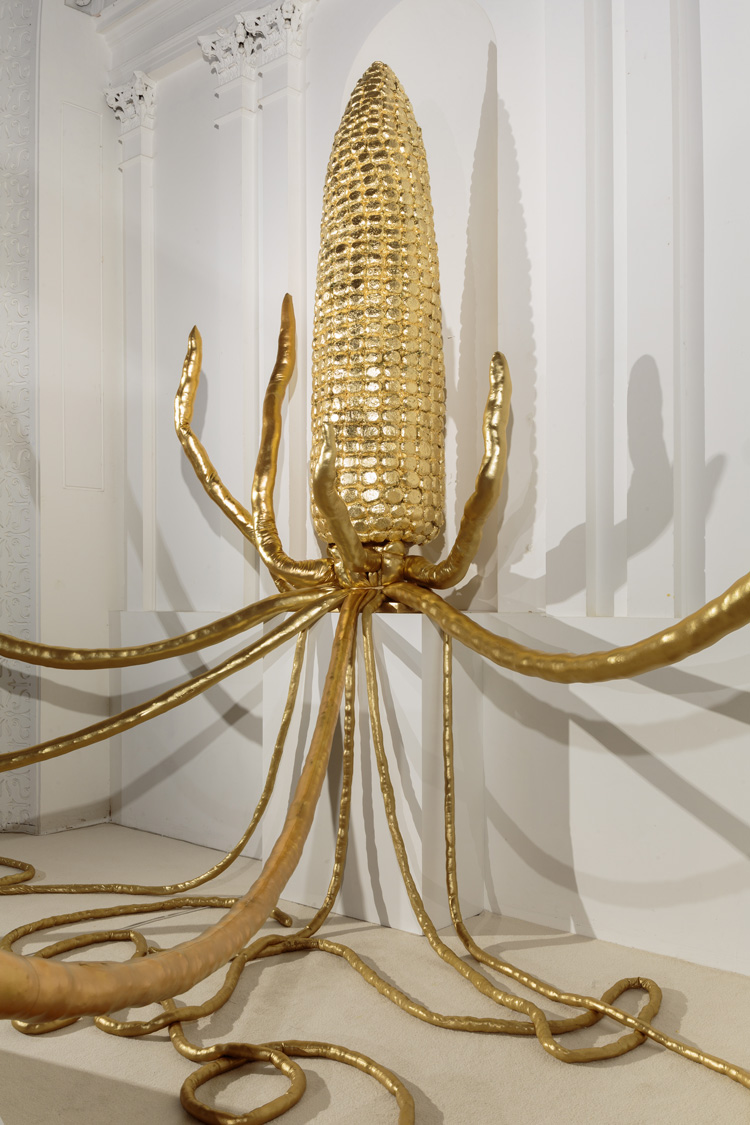
Trulee Hall, exhibition view at Zabludowicz Collection, London, 2020. Photo: Tim Bowditch.
Hall spoke to Studio International via Zoom, offering insight into her musical background, her use of symbols – and the meanings associated with her golden corn-on-the-cobs – and what she thinks of her work being described as “erotic grotesque”, and following in the psychosexual artistic legacy of such artists as Paul McCarthy and Mike Kelley.
Anna McNay: You work across many mediums – video, sculpture, claymation, paintings, soundtracks and kinetic mechanisms. Do you have any particular medium you feel most at home with, or do you typically create whole installations that mix them up?
Trulee Hall: Good question. I would rather not have to choose one medium, because I love how they all work together as a whole. Usually, when I set out with an idea, I start with a painting and a drawing, or sometimes I just go straight to the painting. That’s how I begin the videos. The painting forms what I’m going to do in the video. So, although I could choose one or the other, I would rather not. When you put them all together, and you have music and sound and lights and colour, it’s painting, it’s sculpture and, to me, that’s the complete artwork, it’s all of it together. I’m greedy, I want to do it all.
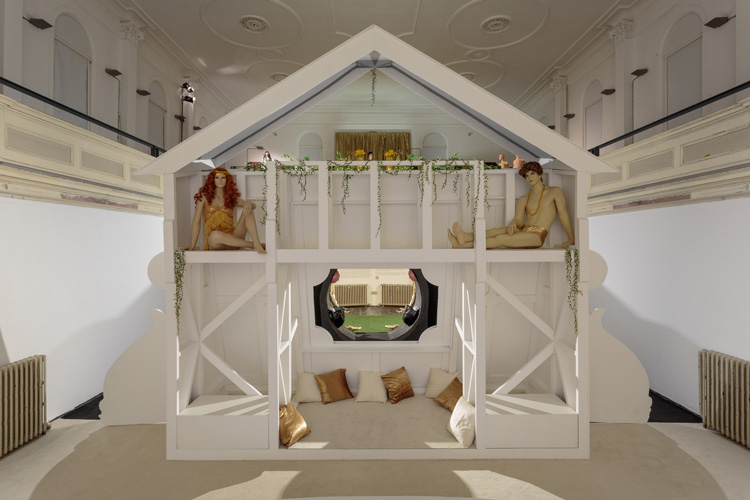
Trulee Hall, Tongues Duel the Corn Whores, An Opera, 2020. Exhibition view at Zabludowicz Collection, London, 2020. Photo: Tim Bowditch.
AMc: I was going to ask about painting, because I know you have spoken before about it being an integral part – the basis, if you like – of your practice.
TH: That’s my origin, I guess. People generally think of me more as a video artist than anything, but I sell more paintings, and that pays for the videos. And, recently, I did an opera at the Zabludowicz Collection, which was exciting as I got to forefront my music, as well, which is my background. Like I said, I’m greedy. I want to do all of it.
AMc: We will come back to the music, but can you talk a little first about the clay and claymation? What came first? Did you always do the claymation, or did you start making clay sculptures and then progress?
TH: When I was an undergrad, I started making videos. I was 19, and I was frustrated with the way things looked in reality. Reality is so boring. My early videos were all stop motion, and I used clay and collage, moving the pieces of paper around. For me, this was a way to be all-powerful. I could make something really magical – create a whole new world – using pieces of paper and some clay on the tabletop. I still make miniatures, obviously, and I always make models – small versions of my shows, when I am setting up, figuring out what is going to go where. I love miniatures, but it’s really fun to do things large-scale also.
AMc: Are those miniatures purely studies, or do you show them in exhibitions, or incorporate them into installations, as well?
TH: Sometimes I have used them in installations, and I like to, but I usually use them mostly in videos. I wanted to ship the claymation set that I used for the opera film over for the exhibition, but there wasn’t enough time. I think it worked out fine, though, because you see it plenty in the film, so it’s almost not necessary to have it in real life.
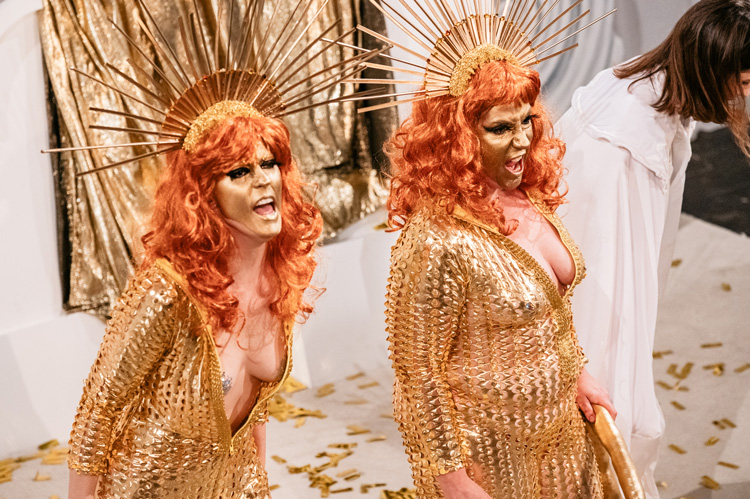
Trulee Hall, Tongues Duel the Corn Whores, An Opera, 2020. Photo: Mike Massaro.
AMc: Let’s talk a bit more about the opera. It was performed at the Zabludowicz Collection in March, just before lockdown.
TH: Yes, exactly, early in March. A few days later and we wouldn’t have been able to do it.
AMc: How long were you working on it for beforehand?
TH: It happened very quickly, because I was really busy with so many other projects – I had gallery shows going on and commissions – so I wrote the bulk of the opera in a month. It was eight acts in total, and I spent a lot of time on acts one and two, and so the rest of it was quite rushed.
AMc: How did it come about? Did the Zabludowicz Collection approach you, or did you suggest the idea of doing an opera?
TH: They proposed it to me because they were having an opera series. They said: “You’re musical. Do you have any ideas? Do you want to do an opera?” It was a dream come true. I would never have thought I would have had that opportunity. It was such a cool kick in the pants to me because it allowed me to think even bigger, and on a larger scale, and to do something live.
The opera was an hour long, whereas, usually, my videos are around 12 or 15 minutes, so it really extended the parameters of what I could do. And, obviously, doing something live, versus being recorded, is a totally different thing. So that was really cool. I always do the choreography and the soundtrack for my videos, but this was live with real instruments and a conductor – really next level for me.
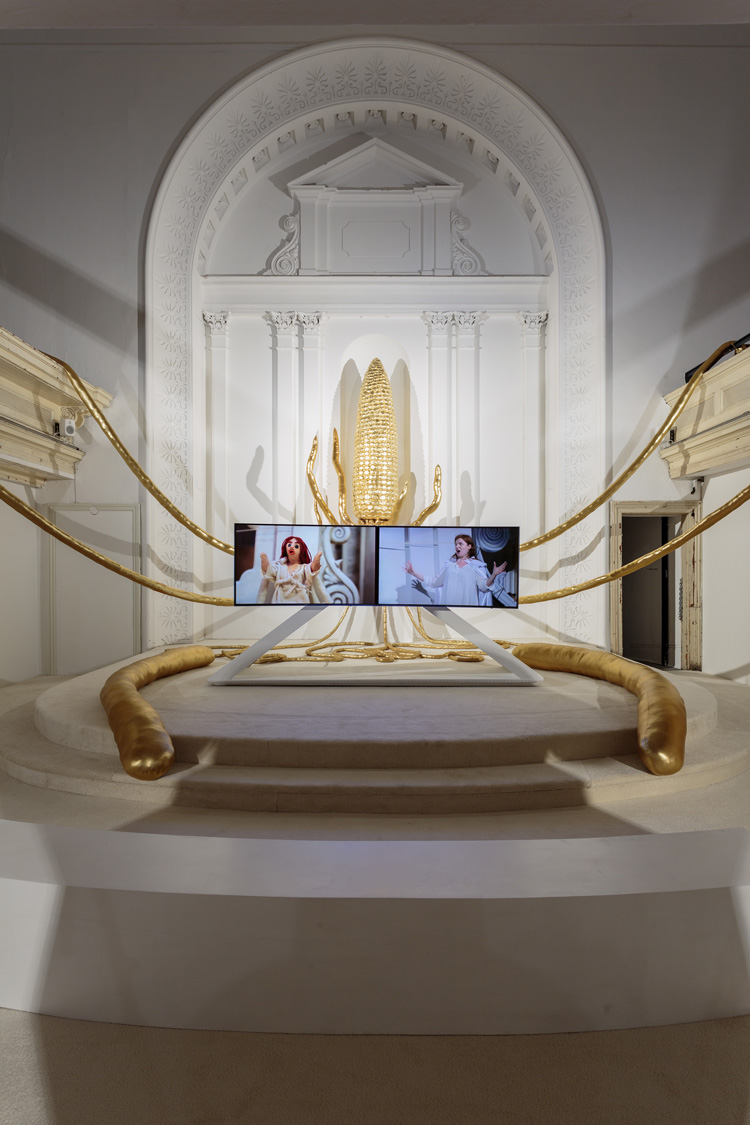
Trulee Hall, Tongues Duel the Corn Whores, An Opera, 2020. Exhibition view at Zabludowicz Collection, London, 2020. Photo: Tim Bowditch.
AMc: Was the film made during the live performance, or was it something entirely separate that you made afterwards?
TH: We filmed it live, but we also filmed our dress-rehearsal day. It was still a rehearsal, but we used special lighting, and everyone had their costumes on for the first time. It was a good opportunity for all the performers to really practise with a little pressure on. The film was a mixture of the live performance, the dress-rehearsal day, and also some CGI and claymation. For me, that was a way of filling in the gaps. For instance, the rapper character couldn’t remember his lines. He pulled it off live, but, on the dress-rehearsal day, he couldn’t remember his lines. With the claymation and CGI, you can fill in the gaps where things weren’t perfect. If you have any inconsistencies, you can just make it in claymation, and, in claymation and CGI, you can do things that you can’t do in reality, such as make people float through the air and make snakes come out and go into space. I use that as a next-level creative licence. I made the characters in claymation bolder – they’re crying, with big tears coming out of their eyes. You can really exaggerate, I guess, and do things that defy gravity.
AMc: What was your role during the performance of the live opera? Were you effectively the director? I know you used to perform in your works, but you don’t any more.
TH: Exactly. Early on, I was a performance artist, but I was the director of the opera, and, of course, I wrote every bit of the music. We worked with a conductor, Michael Coleby, who was amazing. He helped train the musicians and practised with the professional opera singers, so I had help translating my ideas into such a way that a cello player could follow along. Originally, I wrote all the music on a mini keyboard. It was all done on a computer. I could decide, for example, that this would be an oboe part and then play it in an oboe sound. The computer does create less work for you, but it doesn’t think like a human, so the translation from the computer to the actual orchestra instruments was quite a process.
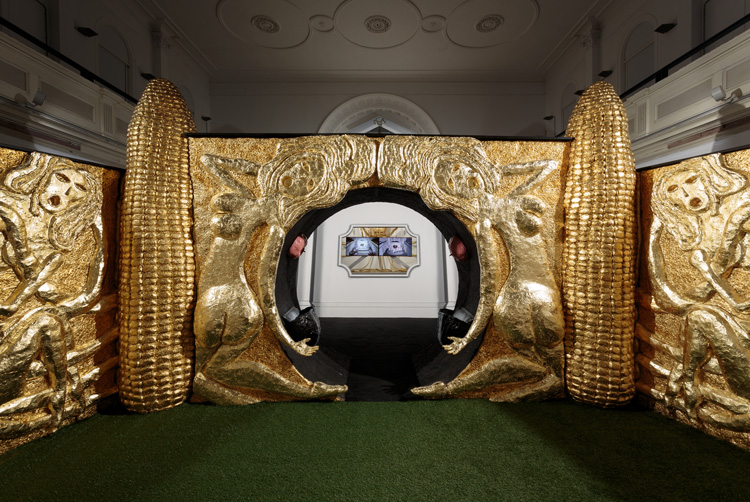
Trulee Hall, exhibition view at Zabludowicz Collection, London, 2020. Photo: Tim Bowditch.
It was all my ideas, and I picked the costumes and sets. I had a ton of help with the choreography, though. I flew my amazing friend Jessica Emmanuel to London, and she stayed with me in our flat. We went through all my ideas, and I told her what I wanted, and what the emotions and feelings and some of the basic movements should be. She really helped stage-direct the whole thing, and to translate my ideas into something that the dancers could understand.
We didn’t have a lot of time to rehearse. Basically, everyone learned their movements and their music in one week, with really long, intense days and a lot to remember. I could not have done it without Michael and Jessica. I had to be in five places at once. I didn’t sleep for three weeks.
AMc: As you have mentioned, you have a musical background, and you were, in fact, a rock star before you were an artist.
TH: I did produce three albums of my music that were very popular. It was sort of indie rock – trippy, noisy, sweet, emotional – a voice layered with lots of harmonies. I wouldn’t say I was a rock star, because I’m quite shy. I learned to play all the instruments, so it’s complicated when you want to multitask like that, but you can only pick one instrument to play live. And then there is the stress of dealing with a huge audience staring at you. You can’t wing it, you have to remember every single note. It’s just stressful. I prefer to play and record everything at home alone.
AMc: Is that part of the reason why you stopped performing your artworks yourself, as well?
TH: Not exactly. When you are playing a complicated musical composition, you have to memorise every note, and if you get one note wrong, it can really throw you off. A lot of my performance artwork was done in front of a video camera, so I would press record and then do my performance. It wasn’t like other people were watching. I did a lot of live performances as well, and it would make me very nervous, but you can ad lib a bit and be spontaneous in the moment. The main reason I decided to take myself out of the work is because I’m using a lot of archetypal stereotypes of women, and, when I play them, people read it as me. I needed to remove myself to create a conceptual space between me and the performance. As the director, if I want to have someone playing a goth character, then I hire someone who is a goth already, rather than me dressing goth. It was really liberating for me to not have to try to translate myself into these different roles. I also love playing with different body types and different ages. I can have the ideas and translate them with other people. Then, as a director, I can man the camera and the lighting and be more in charge of the way the whole thing looks. If you are performing, you can’t see what it looks like.
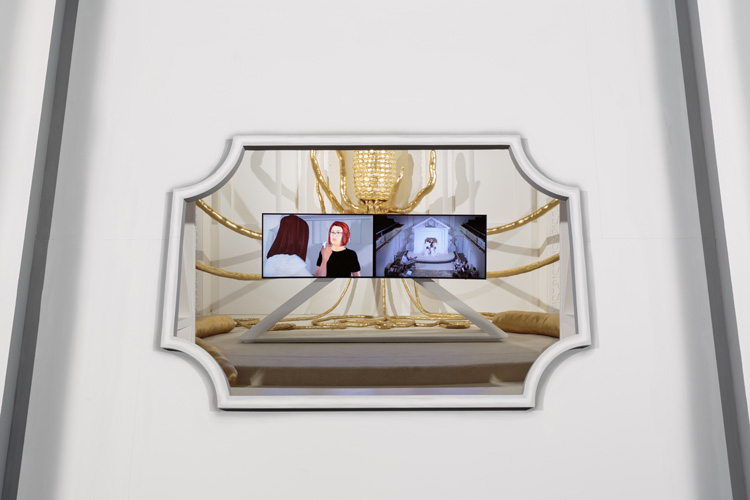
Trulee Hall, Tongues Duel the Corn Whores, An Opera, 2020. Exhibition view at Zabludowicz Collection, London, 2020. Photo: Tim Bowditch.
AMc: Yes, you can’t be everywhere at once.
TH: Exactly. It was a very logical progression. I’m very happy to take myself out of it, so people don’t read it as personally. It’s not about me.
AMc: Your work has been described as continuing the psychosexual artistic legacy of such artists as Paul McCarthy and Mike Kelley. Who else would you say has particularly inspired you?
TH: I would say, especially in terms of what I was just talking about with the female roles and archetypes, Cindy Sherman has been really influential on me. She could play all these different characters, female archetypes, and people didn’t read them as her. She was really inspiring to me early on. And, of course, Louise Bourgeois. I love her. She is so brave. I love her paintings. I love her sculpture. I love her persona. I love everything about her. I don’t know how to explain it. Paul McCarthy really pushes boundaries. I’m from a conservative family, so the idea that you could do something like that was like: “Wow, is this allowed?” Something really sexual and wrong and messy. It was really inspiring and fun for me. I’m really happy that I can be a female version of that, if that makes sense? My work has boobs and vaginas, and it’s from a different perspective. In fact, I would say it is a little bit sweeter and more fun, even in its dark messiness. I’m happy to be related historically to these artists, especially as they are from LA as well. Jim Shaw, Mike Kelley, Paul McCarthy – I know all of them pretty well, and I worked for Mike Kelley [who died in 2012] and we were really close. I have had the opportunity to get to know their art practices in depth. But I align myself with the feminist historical trajectory as well.
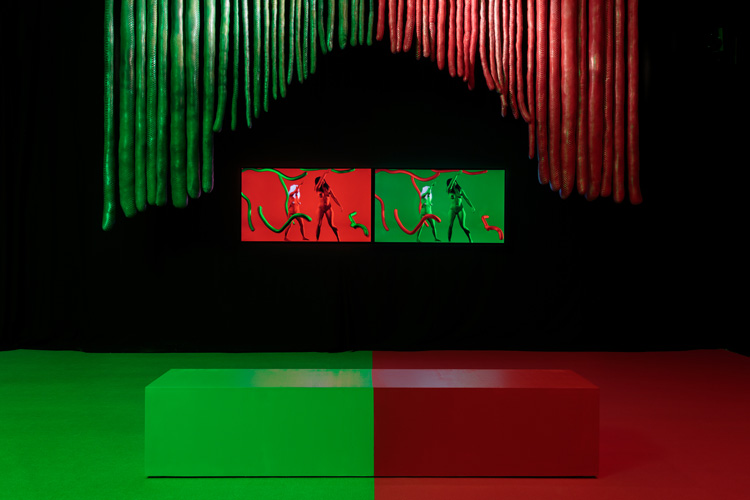
Trulee Hall, Serpent Dance for the Red Witches, 2018. Exhibition view at Zabludowicz Collection, London, 2020. Photo: Tim Bowditch.
AMc: Your work is feminist, obviously, but you also use a lot of terms in your titles, which might be seen as derogatory. “Whore” and “witch”, for example. How do you intend these titles and terms to be understood, and do you intend to subvert, or even invert?
TH: The word “witch”, to me, is not a bad word at all. I embrace that word and consider myself a witch in the best possible way. To me, it’s a really empowering word. It gives an agency. For instance, Serpent Dance for the Red Witches (2018) is a story about Adam and Eve, but there’s no male, so it’s just Eve and Eve. Eve is conjuring the snake. She’s actually asking for the snake, whereas, in the Adam and Eve story, she’s the vulnerable one. Here, she’s conjuring the snake, saying: “Come into me. I want the knowledge of good and evil. I want consciousness.” In the Adam and Eve story, woman is the scapegoat for the fall of man. So I’m using these words and these images and twisting them to be more my version, which is one of empowerment of the female perspective.
And the word “whore” – I am using that in a nice way, too. It’s like someone who is super-embodied sexually and empowered by her own sexuality. That is a cool thing. In the opera, I set up these dichotomies between the two polar opposite sides of what you would think of as “woman”: pure, innocent and righteous versus an overly sexualised, hedonistic being. To me, they are two sides of the same coin. I set up these dichotomies, and then I break them down. I wouldn’t say that, when I say “whore”, it’s a bad word. In the opera, the whores are the coolest chicks around.
AMc: You talk about building up dichotomies, but, at the same time, you manage to escape the constraints of the binary – especially in terms of gender and sexuality.
TH: Yes and no. It’s not that I’m avoiding the dichotomies, it’s that I set them up, and then I break them down. A lot of them use older women and younger women to play the same role. Even with CGI and claymation, I love having them next to each other, because one is really homemade looking, and one is really robotic and cold. At first, it’s really jarring to see the differences between the two mediums, but then, as you watch, you forget which is which. It’s as if they become part of the same piece. Even though they are opposites, they end up becoming part of the same whole.
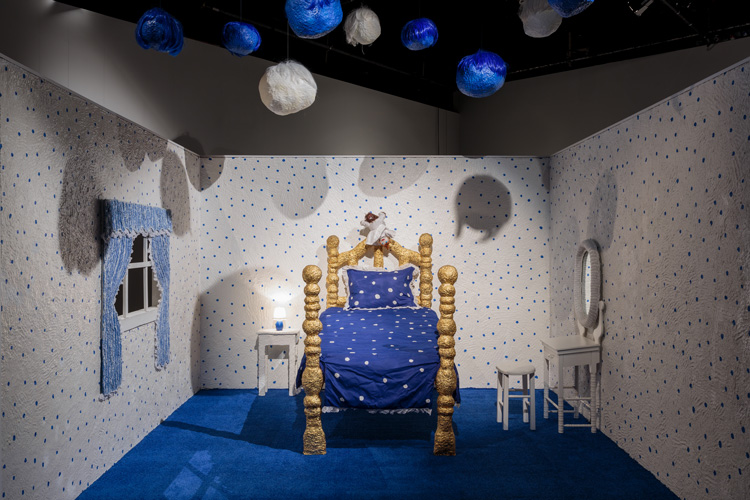
Trulee Hall, Polkadot Bedroom, Nightmare Set (Girl/ Monster), 2018. Exhibition view at Zabludowicz Collection, London, 2020. Photo: Tim Bowditch.
AMc: Before we move away from words and language, can you say a bit more generally about where the inspiration for your titles comes from? Sometimes they are quite poetic and euphemistic, but they are also quite literal in many ways.
TH: Yes, usually my titles are pretty literal. I don’t think about them until I am done with the work. Some things, like the Boob Dance (2018), well, that’s just what it is. I could make up a flowery title for it, but it is just what it is. I try to be literal. Serpent Dance for the Red Witches sounds flowery, but, if you look at the painting, it is just the title of what it is. Untitled (Polkadot Bedroom Installation) (2019), again, that’s just what it is. The titles are usually descriptive, I suppose. Maybe I’ll throw in a little bit of what I’m thinking. Polkadot Bedroom, Nightmare Set (Girl/Monster) (2018) is still really descriptive, but it might give you more of a hint to my thoughts as well. Titles, to me, are just something to name the work. I’m not necessarily trying to explain anything through the title.
AMc: You said the titles might give a clue to what you are thinking, and obviously a lot of thought goes into your work, but are there also specific feelings attached to the work, and are these something you would want your audience to pick up on?
TH: I think I would have to answer that differently for each work, because my inspiration, or point of departure, for each work will be different. But, overall, I want people to feel as if they are entering a new world. If you visit one of my installations, you step inside a different environment. They invite a way of looking at the world from a separate reality. This is not the real reality any more. For instance, when you enter my show at the Zabludowicz Collection, you have to go through a tunnel, and you’re surrounded by these gold women, writhing with snakes, and boobs squirting milk. It’s a rite of passage to even go inside. I love people to have a new experience, almost like going into a haunted house or something, where they wonder where they are. An alternate reality. I try to create an environment that elicits a feeling of openness. When you step into a gallery, you might think you know what to expect, but I want people to feel a bit off-guard, not to know what to expect, which makes people more open-minded, almost from a childlike perspective.
I do try to provide eye candy, too, so it’s really visually interesting at the same time as challenging conceptually and politically. It’s like I’m laying out a welcome mat – “Come on in, come on in, it’s going to be fun!” – at the same time as feeding them medicine. A spoonful of sugar, then medicine. I want people to have fun, but also to be challenged and to go away thinking about the work and to revisit it in their mind later on. There are historical references, and I’m working with art history, so there are many layers. I want people to be able to experience the work wherever they are at personally. Even a janitor who doesn’t know anything about art could have some kind of experience.
AMc: What role does scopophilia or voyeurism play in your work?
TH: That’s a topic I use a lot, especially in some of my earlier works. And in the Polkadot Bedroom, when you first walk into the gallery, there is a window, and you are peering through the window to look into this little girl’s room. You are automatically a creepy guy, like a Peeping Tom, and I want people to feel implicated in that role. If you look at a naked woman, you have a certain power over her. But, in the other pieces in the same room, I have a naked woman painting a naked woman. It’s a model and the artist becoming the same – they’re on the same power dynamic level. I want the viewer to realise how active their viewing is, and what it is they are looking at, and what it is they are implicated in. If you look at any historical painting show, there will be lots of nude women painted by men, from the male perspective. I’m switching that round to be from a female perspective, but I want the viewer to feel implicated and realise how powerful their looking is.
AMc: Your work has been described as “erotic grotesque”. Do you think that is an apt description? What do you understand by it?
TH: Yes, I like that term. It makes sense to me. I wouldn’t say all my work is grotesque, because sometimes it’s beautiful, and sometimes it’s not necessarily supposed to be sexy. I’m purposely messing with stereotypes of sexiness. For instance, having giant boob costumes that take over the whole figure. It’s purposely funny, and also grotesque, but it also pays attention to the fact that women are often thought of as their body parts, more than for their mind or consciousness.
When I’m casting the roles for each video, I tend to gravitate towards women who are really sexual and in touch with that part of their body language, so they are empowered in their own sexiness. It’s not that they are model-skinny or typical in any other way. So to say “grotesque” is maybe not the best word, but I do like it because I can’t think what the right word would be. It’s complicated. It’s like sexy, but wrong, but funny and conceptual. How do you describe all that in one word? I find that sex, in general, is a little bit grotesque. It’s fun. It’s raw. It’s messy. It’s horrible and animalesque, but in such a beautiful way.
AMc: It is all the contradictions.
TH: Exactly, yes. A lot of women I work with are dominatrices or strippers, happy in some sort of role-play position, so they feel sexy when they are performing for me.
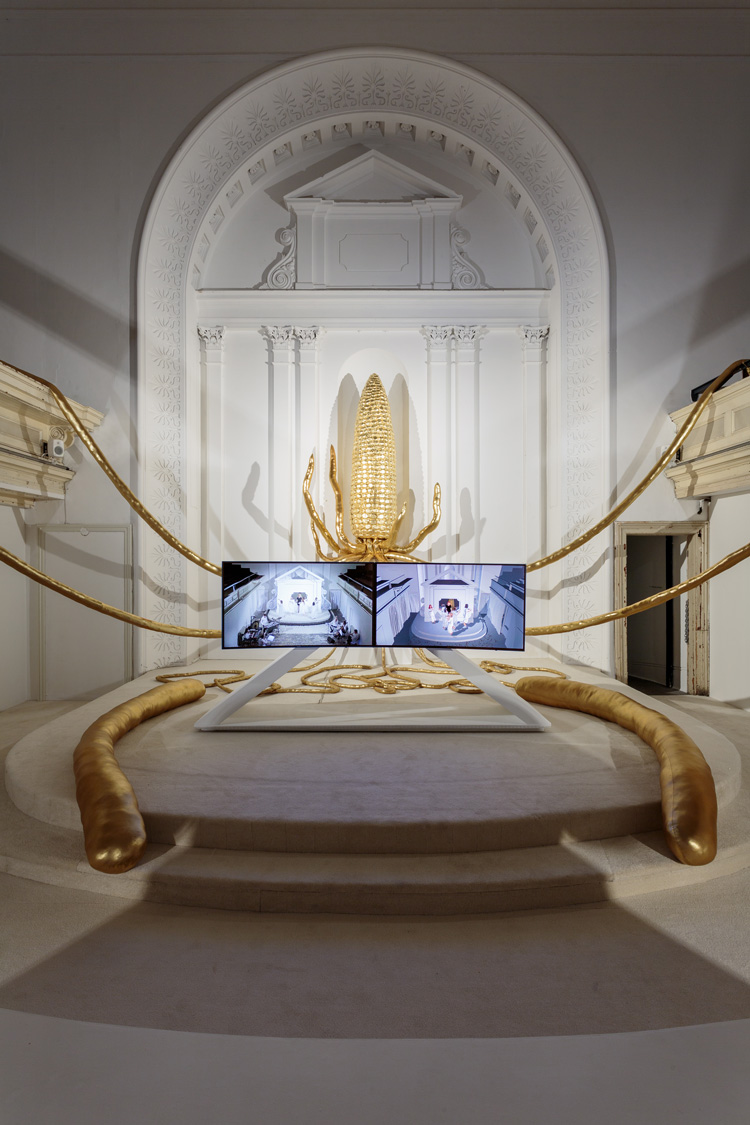
Trulee Hall, exhibition view at Zabludowicz Collection, London, 2020. Photo: Tim Bowditch.
AMc: I guess role play is quite a good analogy, because your performers definitely seem to be stepping into different characters and, as you have already said, archetypes. On which note, I can’t not ask you about the corn-on-the-cobs …
TH: Of course – I love talking about my corn-on-the-cobs! In this show, and in the opera, I have several giant golden corn-on-the-cobs. I use the corn as a symbol of power. And the corn cob is actually the female part of the corn plant. It’s a phallic female. It’s the flower of the plant, but, of course, it’s a phallic shape. It’s almost like a dildo, a disembodied phallic symbol, but, in this case, it’s female. The wispy parts on the top of the corn, the little seed part, is the male part on the corn. It’s pretty funny. To me, it’s a symbol of power, but from a female perspective. And the colour gold symbolises money and wealth. In the opera, the women want the corn, they want the gold corn, but it’s not males they want, they want the female power. The money and the power, the influence – that’s what they want. They don’t need the male for their sexual pleasure. And they don’t need the male for their power.
So that’s one thing. I’m also from Atlanta, Georgia, where we have lots of farmers, so I also use the corn as a symbol of simplistic living, almost like idealising a simpler way of being, harking back to the days when we all lived off the land. It is used very often as kitchen decoration in Georgia. I’m really into decoration and decorative elements. And, thinking politically, corn has so many overtones of a genetically modified organism, of being a monster plant that has been overly cultivated and turned into a gross product. Humans actually created the corn plant. It used to be a little weed and it was one of the first genetically modified, cross-pollinated plants.
Also, an early creation myth from the Mayan culture tells that man was created as corn. The Popol Vuh tells the story of the Hero Twins, who duplicated themselves from corn, and that’s how humans were created. As I’m also referencing the Adam and Eve story quite a bit, it’s interesting to have this other creation myth as another way to think about the corn.
AMc: That’s really fascinating – especially the fact that the corn cob is the feminine part, which I didn’t realise. Do you make this clear in your work? Is it important to you that your audience should understand all of the symbolism?
TH: The more my work is written about, the more it will be obvious, but it’s not like I want to put a sign across it or anything like that. It’s something to be discovered. As I’ve said, my work has many layers to it, and you might not see them all on first viewing. But even if it’s not made super obvious, people will figure it out over time. I try to be really generous. There are lots of things you can find out on your own just by looking, but, if people want to know more, they can dig deeper.
AMc: You have talked a bit about gold, and your colour palette in general is quite kitsch and exaggerated. Is this just part and parcel of your exuberant style?
TH: Yes, it is. But I think of colours symbolically. In the opera, the women are all in gold suits to show off: “It’s shiny, look at me, I’m shiny!” It’s like they are trying to get attention because it’s a very flashy colour. The more righteous women wear all white because they are trying to be pure. If something is really pink, it’s supposed to be girly, and I’m exaggerating the girly aspect. Or I’ll use a camouflage colour, a typical army camouflage, which means something is being hidden behind a veneer. It depends on the piece, but I think about the colour as an emotional and symbolic resonator for the idea.
AMc: Maybe the opera is different, but do your works typically have a narrative, or is it more a case of the various layers of meaning you have mentioned, and potentially different stories that could be pulled out from these?
TH: Again, it depends on the work, but, generally speaking, when I’m creating something, the ideas come to me, and I take them on almost like a relationship. Then, the deeper I dig, the more the layers pile up on themselves. Polkadot Bedroom, for instance, is a story of a nightmare and the vulnerability of a little girl, and the dichotomy there is that she is both the mother and the child – she plays both roles; the mother and daughter are the same character. Then the little girl is also a monster, so she becomes her own nightmare. It’s just another part of herself – layers of her personality. Without seeing the video, it might be hard to understand what I’m saying, but, in very simple terms, I start with an idea, and I layer it from there.
In that piece, too, the polka dots on the wall of the bedroom are directly referencing part of my own history, because, when I was a little girl, I had small blue flowers all over my wallpaper and bedspread. I had really bad eyesight, though, so they just looked like blurry dots to me. I created the installation based on this memory from my childhood, so that piece is slightly more narrative, just because it comes from my personal history. Each piece is a little different in terms of where the initial inspiration comes from, and the layers of reference might come from my own history, or from some kind of archetypal, symbolic, historic place.
AMc: Coming back to the exhibition at the Zabludowicz Collection, how much of the content was made specifically with that show in mind?
TH: I had a huge show in LA in February 2019, and the Zabludowicz Collection bought quite a few pieces from that, including the gold tunnel with the entryway with the giant corns, and the Polkadot Bedroom. There are many brand-new elements, too, though. The very last work you see, Two Heads, Two Ways (2020), is a completely new installation. I just finished the video two weeks ago. And then, of course, there is the opera. The live performance happened early in March, but I used elements from the set and the costumes in the show. The giant corn and the altar were made recently in LA and shipped across the ocean. So it’s a mixture of things from my previous show, things from the opera, and then some totally brand new things.
AMc: How have you been affected by Covid? Were you able to come over for the installation?
TH: Yes, I was there for a month, but the first two weeks I had to quarantine. I was in my apartment for two weeks, but I needed that time to edit, so it was OK. It was almost like a little editing residency. It was me alone with my computer. I used that time wisely.
AMc: Normally you are based in LA. Do you have a typical daily studio routine, or does it depend on what you are working on?
TH: It really does depend on what I’m working on. I like to have a lot of time alone, which doesn’t always happen, but I try for that, because that’s when ideas come to me, and I can fully “play” in the studio, generate new content and do sketches and paintings. I like to get in my weird place in my head, Trulee’s world. There are other times when I have deadlines, and I have to have people helping me. The studio can be quite busy when I have staff and people working to finish something on time. Luckily, I have a really large studio, so it works pretty well if I need to jump into art-production mode. My happy place is when I can just have time by myself. If I’m working on a video, then I’ll just be in front of my computer all day, but other times, when I’m creating paintings and sculpture, I’m messier. I like to work outside, and I’m really lucky because the weather here in LA is almost always good. I have a courtyard area, and sometimes I’m outside all day. I’ve been a full-time artist now for six years. It’s just what I do. The only side gig I have had, for the past three years, for three weeks out of each year, is working on an NBC TV show called Making It. It’s a crafting competition show. It’s almost like Iron Chef, but for creators. The contestants are given an assignment, and they have to rush around and build their creations. I help them build. I am behind the scenes. They try to pretend that the contestants make everything, but actually it’s people like me who do most of the work. I’m the ideal person for that because I can sew and weld and do carpentry and paint. I have all the different skills that you might need. It’s a fun, yearly practice. It gets me out of my head and focuses me on other people’s projects. And I love the behind-the-scenes aspect of working on a TV show – all the camera, lighting and production side – that helps me when I’m doing my own videos. We are due to go into production this coming Monday, as it happens. After that, I’m really looking forward to making some new work. I’m going to dive back into the studio and see what comes out. I’m ready for the next phase.
• Trulee Hall is at the Zabludowicz Collection, London, until 14 March 2021.